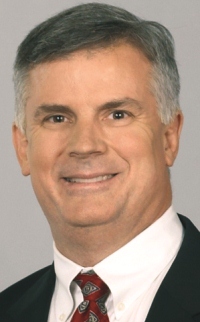 Eric Smith, President and CEO, Swiss Re Americas
Eric Smith, President and CEO, Swiss Re Americas
Latin America's growth and the potential for both our clients and the reinsurance industry is the lead story for 2013, and it will be an interesting one for many decades to come. Mexico, Columbia and Brazil are the three countries we find extremely interesting. You see a lot of big infrastructure projects, which leads to Engineering and Property covers. In all three of those countries [you can see] the emergence of the middle class, and this is driving a lot of opportunity in the insurance space.
The lack of robust economic growth is by far biggest challenge. The economy is not growing at a rate that allows insurers to see the kind of organic growth they would like to have. If the economy doesn't pick up, then what we saw in 2012 we will see in 2013.
Second challenge: the weather. Right now, we are still in the immediate aftermath of Sandy. Part of what we will see this year and more next year is more dialogue about what do we need to do to prepare for the next one. There will be a next one. It is just a question of when and how severe.
 Sean McGovern, Director, North America, General Counsel and Risk Management, Lloyd's
Sean McGovern, Director, North America, General Counsel and Risk Management, Lloyd's
In terms of growing your business in 2013, the outlook is quite bleak, I'm afraid. The rate environment remains challenging. Although some lines are seeing improvements; it remains spotty. That means it's going to be all about the quality of your underwriting; there's not much else to reach for. Extra challenges come in the oversupply of capital in the industry: 2012 capacity is at record levels, in spite of the industry absorbing major cats in 2011 and 2012.
We remain focused on our core markets: the U.S., U.K., Canada and Europe, while also looking at faster-growing economies. However, low global economic growth will continue into 2013, fueled by such factors as the Euro crisis and negotiations on the Fiscal Cliff in the U.S. and what impact it may have on the U.S. economy.
 Pina Albo, President, Reinsurance Division, Munich Reinsurance America Inc.
Pina Albo, President, Reinsurance Division, Munich Reinsurance America Inc.
Primary carriers will continue to experience some primary rate changes, which will increase both the top line and profitability of their portfolios. The E&S market in particular is showing strong signs of improvement. However, these rate actions, while positive, do not allow the industry to cover its cost of capital.
Increasing frequency and severity of natural catastrophes will continue to be a long-term challenge for the industry, especially in North America which has experienced the largest increases in weather-related loss events over the past 30 years. As reinsurers, we must focus on risk-adequate pricing, but pricing is not the key in the context of climate change. We must continue to analyze and understand the risks and to pursue risk-mitigation and adaptation efforts.
In the U.S., investments in infrastructure projects totaling $1 billion are expected to create 18,000 new jobs, 40 percent in the construction sector and 60 percent long term in sectors such as manufacturing, education, transportation and energy. Insurers and reinsurers can support these projects by participating in infrastructure investments and providing insurance solutions.
 Michael Fergang, Chief Information Officer, Grange Insurance
Michael Fergang, Chief Information Officer, Grange Insurance
The amount of data that's available to insurers is exploding. Carriers that excel at harnessing this data to shine a light on profitable paths and new opportunities will have a big advantage over carriers that struggle with the volume and breadth of information.
Growth in a continued soft—or at best, 'squishy'—market will be challenging. In the current economic climate, investments in customer/agent capabilities and any initiative that will help retain current customers helps grow the bottom line. Operational efficiencies, although not as exciting, are always on the radar and help us redirect resources to our most valuable initiatives.
The extended market challenges and uncertain investment landscape will continue to challenge carriers to “do more with less” and to continue focusing on initiatives that cut cost, increase efficiencies and enhance relationships with our agents and policyholders. This is the 'new normal,' and will continue to challenge us for the foreseeable future. To compete in the independent-agent market, we have to align our efforts with the needs of the agent to drive value and make them want to write business with us.
 Jon Hall, Executive Vice President, FM Global
Jon Hall, Executive Vice President, FM Global
From a supply-chain perspective, large, technically oriented insurance buyers have fewer places they can go that can offer the broad coverage, capacity and specialized services they need. Insurers that can understand and respond to those needs are the ones that stand to gain.
There are fewer and fewer carriers capable of delivering a consistent global-insurance program to organizations that have a multinational footprint. This presents growth opportunities for those insurance organizations that can do so.
 Tom Motamed, Chairman and CEO, CNA Financial
Tom Motamed, Chairman and CEO, CNA Financial
With declining investment yields, adverse catastrophe results and slowing reserve releases, 2013 will see greater emphasis on underwriting and pricing integrity. There is less room to be bold when you don't have the yields and reserve redundancies of prior years.
Underwriters will spend their energies on improving margins by increasing rates, particularly on catastrophe-prone business and Workers' Compensation. At the same time, underwriters will continue to look at the developing markets as new sources of growth and will begin to put more resources behind such industries as health care, technology and specialty lines.
Regulation is front-and-center, with strengthened solvency regulation moving forward in the U.S. and internationally on a number of parallel tracks. We need to keep reminding regulators, legislators and the general public that the insurance industry was never in crisis, and our ability to meet our obligations was never in question.
 Bradley Kading, President, Association of Bermuda Insurers and Reinsurers
Bradley Kading, President, Association of Bermuda Insurers and Reinsurers
“Growth” is not the operative word for 2013. The operative word continues to be how to earn an underwriting profit in a world of limited investment income.
To be a global player you have to be a global player: Clients expect you to be able to meet their needs in the U.S., E.U. and Asia and elsewhere in the world. The developing markets hold promise, but growth will be slow and government intrusion into the business must be avoided.
Protectionism and regulatory overreach are the major challenge for 2013. Limitations on flexibility with capital are problematic. To be an international commercial insurer and reinsurer you need to be able to manage risk, to pool it as necessary, without unnecessary impediments from protectionist regulatory ring fencing or tax policy. Policymakers expect us to write major risks—we are willing to do that—but we can't be hamstrung by overreaching regulation. Regulatory or tax policy imposing ring fencing of capital will limit capacity. Policyholders know that limited capacity means higher prices; a simple law of supply and demand.
There's a chance here that a critical mass of thinking on climate change will cause more insurers and reinsurers to become more outspoken and to increasingly engage with policymakers on adaptation-risk-based pricing; building and planning for resilience; and looking at cat risk from a more holistic perspective.
 Charles M. Chamness, President and CEO, NAMIC
Charles M. Chamness, President and CEO, NAMIC
Property & Casualty insurers, and mutual insurers in particular, have provided an economic foundation for the economy during the struggles of the past few years. As our economy continues to recover, I expect the industry to grow along with it.
Perhaps the biggest challenge for the industry will be the unknown and uncertainty coming from Washington. Our industry is one that saves and invests, and the ultra-low interest-rate environment, combined with continuing infighting on key economic issues in Washington, makes it a tough environment for insurers. The TRIA program is up for renewal, but with the pattern established in Washington of not acting until or after the last possible moment, we need to be concerned about the terrorism-insurance market reacting to this brinkmanship.
We could face a significant explosion of litigation as the Dept. of Housing and Urban Development seems intent on applying the “disparate impact” standard to the pricing and provision of Homeowners' insurance. If enacted, this rule means any underwriting factor could be challenged as discriminatory simply based on statistics that show some variation in the way it affects different racial and ethnic groups.
 Jeff Rommel, Senior Vice President of Field Operations, Allied Insurance
Jeff Rommel, Senior Vice President of Field Operations, Allied Insurance
The industry overall is still challenged with profitability, which has been causing additional rate actions in the marketplace. Producers are challenged with keeping customer satisfaction high—which usually takes more time in servicing and less time in selling.
We anticipate we will see continued strength in the economy in 2013, and this will support our plans to grow profitably. We also believe the industry will see noticeable shifts in classes of business. As profit continues to be a focus, companies will look to get off of or shy away from business that they have struggled to make money on in the past.
Want to continue reading?
Become a Free PropertyCasualty360 Digital Reader
Your access to unlimited PropertyCasualty360 content isn’t changing.
Once you are an ALM digital member, you’ll receive:
- Breaking insurance news and analysis, on-site and via our newsletters and custom alerts
- Weekly Insurance Speak podcast featuring exclusive interviews with industry leaders
- Educational webcasts, white papers, and ebooks from industry thought leaders
- Critical converage of the employee benefits and financial advisory markets on our other ALM sites, BenefitsPRO and ThinkAdvisor
Already have an account? Sign In Now
© 2024 ALM Global, LLC, All Rights Reserved. Request academic re-use from www.copyright.com. All other uses, submit a request to [email protected]. For more information visit Asset & Logo Licensing.








